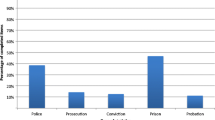Abstract
The issue of youth offending, and in particular whether young people are becoming more violent, is hotly debated in many European countries. It is very difficult to establish trends in juvenile delinquency and violence with certainty from statistical sources. This chapter will present the available evidence in order to inform debate on what has really happened to youth offending in Europe. It will focus on the period after 1990. Before this, officially recorded crime rose rapidly in the post-war years in Western Europe, before stabilising in the later part of the twentieth century. This levelling off was not seen in officially recorded violence, although there is some scepticism as to whether recent rises in the official records reflect actual increases or an increased sensitivity to violence (Pfeiffer 1998; Westfelt and Estrada 2005). It will use various sources to examine trends in offending – and particularly the offending of people who are under the age where they are treated as adults in the criminal justice system – in the countries of the European Union. The chapter will begin by discussing the important problems that affect attempts to compare the available data across countries and time. It will then explore the picture of increasing violent offending that is given in official statistics and use data from victimisation surveys to question whether this increase reflects real increases in the occurrence of juvenile crime in Europe.
Access this chapter
Tax calculation will be finalised at checkout
Purchases are for personal use only
Similar content being viewed by others
Notes
- 1.
Special caution needs to be used in interpreting figures from the new member states, as several of them experienced big changes in their criminal justice systems in the transition from communism during the 1990s.
- 2.
These figures come from police statistics. The definition of a “suspected offender” varies between countries, ranging from being recorded when the police themselves are convinced who the offender is, to being recorded only when a prosecutor starts proceedings against a suspect.
- 3.
In the EU15, the figures are not available for Belgium, Denmark, Portugal, Northern Ireland and Scotland. In the new EU members, the figures are not available for Cyprus, Lithuania and Malta.
- 4.
Data for missing years for individual countries has been imputed by using the average of the previous and subsequent years, or the previous or subsequent year for years at the end or beginning of the series.
Author information
Authors and Affiliations
Editor information
Editors and Affiliations
Rights and permissions
Copyright information
© 2009 Springer Science+Business Media, LLC
About this chapter
Cite this chapter
Stevens, A. (2009). Trends in Youth Offending in Europe. In: Junger-Tas, J., Dünkel, F. (eds) Reforming Juvenile Justice. Springer, New York, NY. https://doi.org/10.1007/978-0-387-89295-5_1
Download citation
DOI: https://doi.org/10.1007/978-0-387-89295-5_1
Published:
Publisher Name: Springer, New York, NY
Print ISBN: 978-0-387-89294-8
Online ISBN: 978-0-387-89295-5
eBook Packages: Humanities, Social Sciences and LawSocial Sciences (R0)




